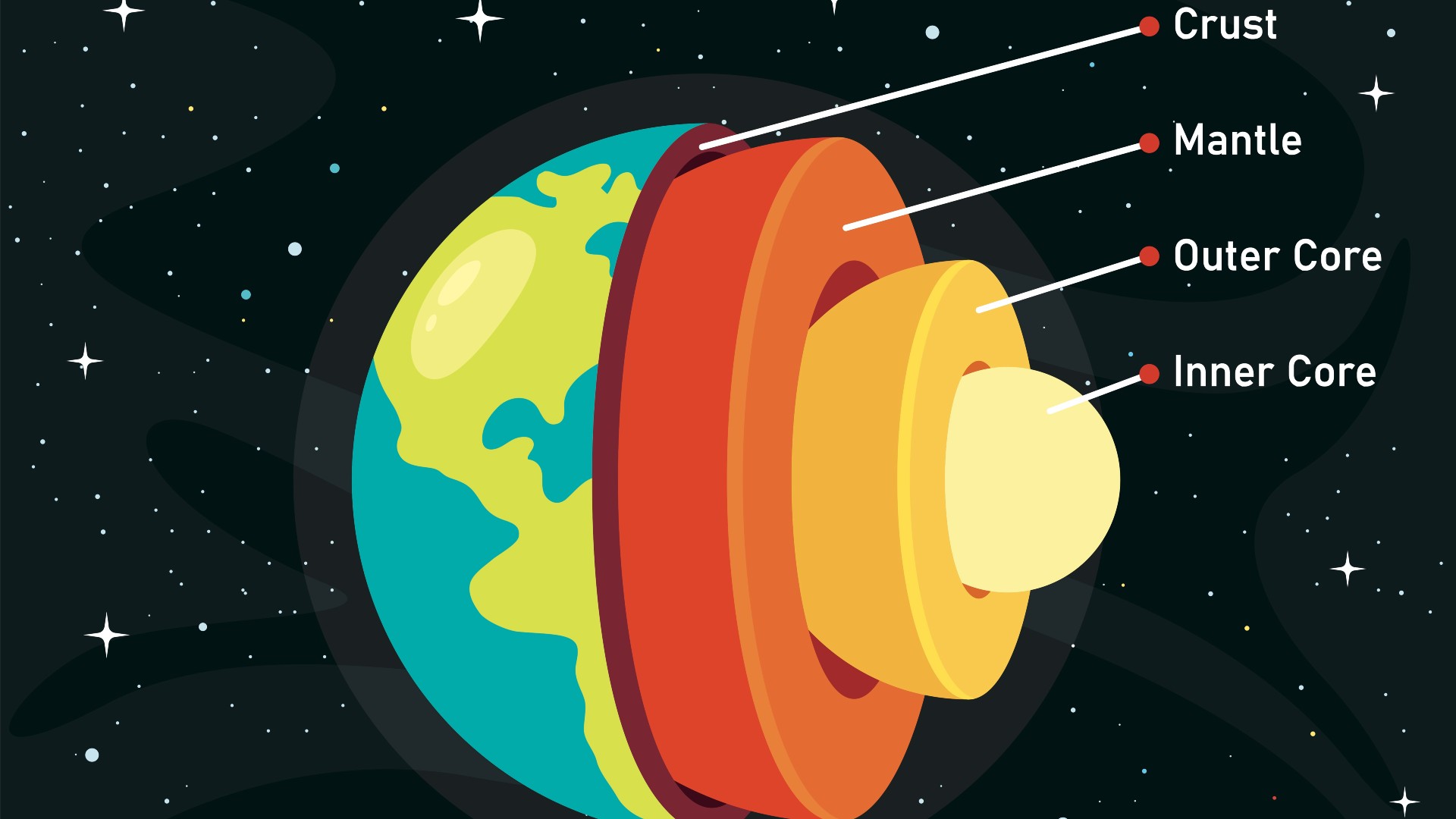'New hidden world' discovered in Earth's inner core
The core isn't a "boring blob of iron" after all.

Earth's "solid" inner core might actually be a bit mushy, researchers now find.
For over half a century, the scientific community thought that Earth's inner core was a solid ball of compressed iron alloy surrounded by a liquid outer core. But new research, published Sept. 20 in the journal Physics of the Earth and Planetary Interiors, suggests that the firmness of the planetary ball ranges from hard to semisoft to liquid metal.
"The more that we look at it, the more we realize it's not one boring blob of iron," Jessica Irving, a seismologist at the University of Bristol in England, who was not involved in the study, told Live Science. "We're finding a whole new hidden world."
Related: 50 interesting facts about Earth
In some ways, Earth's inner core remains as mysterious as it was when Jules Verne published his fanciful "Journey to the Center of the Earth" in 1864. Though scientists have known since the 1950s that our planet isn't hollow as Verne predicted, the planet's interior is still unexplored; the immense heat and pressure are simply too great for any human or human-made probe to travel there. "Unless something awful happens to our planet, we will never have a direct observation of Earth's core," Irving said.
Instead, geophysicists rely on seismic waves generated by earthquakes. By measuring these massive vibrations, scientists can reconstruct a picture of the planet's inner workings in a way that's "akin to a CT scan of a person," Irving said. These waves come in two main flavors: straight-line compressional waves and undulating shear waves. Each wave can speed up, slow down or bounce off of different mediums as it travels through the ground.

For Rhett Butler, a geophysicist at the Hawai'i Institute of Geophysics and Planetology, the new study started as a question of mismatched numbers. Butler was looking at how the seismic waves created by large earthquakes in five different locations travel through Earth's core to the exact opposite side of the globe. But something was off — the quakes' shear waves, which should have passed through a solid ball of metal, were instead being deflected in certain areas.
Get the Space.com Newsletter
Breaking space news, the latest updates on rocket launches, skywatching events and more!
The numbers surprised Butler. He knew the seismic wave math was correct, which could mean only one thing: Scientists had the structure wrong. "When you're in this business, you've got to match the data," he said. So Butler and his co-author reevaluated their base assumption that Earth's inner core was solid all the way through. They discovered that the waves they observed worked if, rather than being a solid ball, the core had pockets of liquid and "mushy," semisolid iron near its surface.
The range of iron consistencies was particularly striking, according to Butler. "We've seen evidence that not only is it not soft everywhere; it's really hard in some places," he said. "It's got hard surfaces right up against melted or mushy iron. So we're seeing a lot of detail within the inner core that we didn't see before."
This research could potentially revolutionize our understanding of Earth's magnetic field. While the swirling liquid outer core drives our planet's magnetic field, the inner core helps to modify the field, according to research published in 2019 in the journal Science Advances. Other planets, like Mars, have a liquid center but lack both an inner core and a magnetic field, according to research from NASA. Therefore, Butler and Irving believe, a deeper understanding of the inner core will help scientists understand the relationship between a planet's interior and its magnetic activity.
Originally published on Live Science.
Earth's "solid" inner core might actually be a bit mushy, researchers now find.
For over half a century, the scientific community thought that Earth's inner core was a solid ball of compressed iron alloy surrounded by a liquid outer core. But new research, published Sept. 20 in the journal Physics of the Earth and Planetary Interiors, suggests that the firmness of the planetary ball ranges from hard to semisoft to liquid metal.
"The more that we look at it, the more we realize it's not one boring blob of iron," Jessica Irving, a seismologist at the University of Bristol in England, who was not involved in the study, told Live Science. "We're finding a whole new hidden world."
Related: 50 interesting facts about Earth
In some ways, Earth's inner core remains as mysterious as it was when Jules Verne published his fanciful "Journey to the Center of the Earth" in 1864. Though scientists have known since the 1950s that our planet isn't hollow as Verne predicted, the planet's interior is still unexplored; the immense heat and pressure are simply too great for any human or human-made probe to travel there. "Unless something awful happens to our planet, we will never have a direct observation of Earth's core," Irving said.
Instead, geophysicists rely on seismic waves generated by earthquakes. By measuring these massive vibrations, scientists can reconstruct a picture of the planet's inner workings in a way that's "akin to a CT scan of a person," Irving said. These waves come in two main flavors: straight-line compressional waves and undulating shear waves. Each wave can speed up, slow down or bounce off of different mediums as it travels through the ground.

For Rhett Butler, a geophysicist at the Hawai'i Institute of Geophysics and Planetology, the new study started as a question of mismatched numbers. Butler was looking at how the seismic waves created by large earthquakes in five different locations travel through Earth's core to the exact opposite side of the globe. But something was off — the quakes' shear waves, which should have passed through a solid ball of metal, were instead being deflected in certain areas.
The numbers surprised Butler. He knew the seismic wave math was correct, which could mean only one thing: Scientists had the structure wrong. "When you're in this business, you've got to match the data," he said. So Butler and his co-author reevaluated their base assumption that Earth's inner core was solid all the way through. They discovered that the waves they observed worked if, rather than being a solid ball, the core had pockets of liquid and "mushy," semisolid iron near its surface.
The range of iron consistencies was particularly striking, according to Butler. "We've seen evidence that not only is it not soft everywhere; it's really hard in some places," he said. "It's got hard surfaces right up against melted or mushy iron. So we're seeing a lot of detail within the inner core that we didn't see before."
This research could potentially revolutionize our understanding of Earth's magnetic field. While the swirling liquid outer core drives our planet's magnetic field, the inner core helps to modify the field, according to research published in 2019 in the journal Science Advances. Other planets, like Mars, have a liquid center but lack both an inner core and a magnetic field, according to research from NASA. Therefore, Butler and Irving believe, a deeper understanding of the inner core will help scientists understand the relationship between a planet's interior and its magnetic activity.
Originally published on Live Science.
Join our Space Forums to keep talking space on the latest missions, night sky and more! And if you have a news tip, correction or comment, let us know at: community@space.com.

Joanna Thompson is a science journalist and runner based in New York. She holds a B.S. in Zoology and a B.A. in Creative Writing from North Carolina State University, as well as a Master's in Science Journalism from NYU's Science, Health and Environmental Reporting Program. Find more of her work in Scientific American, The Daily Beast, Atlas Obscura or Audubon Magazine.










